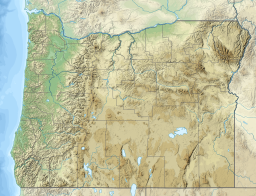Emigrant Lake is a reservoir located 5 miles (8 km) southeast of Ashland, Oregon, at the southern end of the Rogue Valley.[1] It has an elevation of 2,241 feet (683 m) above sea level.[2] The lake has an average surface area of 806 acres (3.26 km2), and an average volume of 40,530 acre-feet (49,990,000 m3).[3] The lake is impounded by Emigrant Lake Dam, which stands 205 feet (62 m) above the surrounding farmland, and is located on Emigrant Creek at the west side of the lake. The spillway is at the northern tip of the lake. Emigrant Creek is a tributary of Bear Creek.
| Emigrant Lake | |
|---|---|
 Emigrant Lake | |
| Location | Jackson County, Oregon |
| Coordinates | 42°09′41″N 122°36′15″W / 42.16139°N 122.60417°W |
| Type | reservoir |
| Primary inflows | Emigrant Creek |
| Primary outflows | Emigrant Creek |
| Basin countries | United States |
| Surface area | 806 acres (3.26 km2) |
| Water volume | 40,530 acre-feet (49,990,000 m3) |
| Surface elevation | 2,241 feet (683 m) |
History
editThe reservoir was created in 1924 when the original 110-foot (34 m) concrete arch dam was built by the Talent Irrigation District for irrigation and flood control.[4] In 1960, the United States Bureau of Reclamation enlarged the dam into the 204-foot (62 m) rock-filled structure standing today.[4][5]
Recreation area
editEmigrant Lake features a large recreation area. This includes a 42-site, full-hookup campground,[6] picnic areas, and two 280-foot (85 m) water slides open from Memorial Day to Labor Day.[7] As of 2022, the slides are no longer operating due to the cost of repairs.[8]
Drought conditions and archaeological study
editIn October 2014, drought conditions prompted the Bureau of Reclamation to order an archaeological study to protect artifacts that have become exposed due to the lake being at less than 10 percent of capacity.[9] During the 2020–21 North American drought, the lake reached 3% capacity.[10]
See also
editReferences
edit- ^ "Wildernet.com - Emigrant Lake, Oregon". Wildernet.com. Retrieved February 2, 2008.
- ^ "Emigrant Lake, Oregon". Southern Oregon.com. Retrieved February 2, 2008.
- ^ Loy, William; Allan, Stuart; Buckley, Aileen; Meacham, James (2001). Atlas of Oregon (2nd ed.). University of Oregon Press. p. 171. ISBN 978-0-87114-101-9.
- ^ a b "Rogue River Basin Project, Talent Division - Oregon". United States Bureau of Reclamation. Archived from the original on December 19, 2007. Retrieved February 2, 2008.
- ^ "Emigrant Dam". United States Bureau of Reclamation. Archived from the original on December 19, 2007. Retrieved February 2, 2008.
- ^ "Emigrant Lake Recreation Area". Jackson County Parks. Retrieved February 2, 2008.
- ^ "Emigrant Lake Water Slide". Guide to Oregon.com. Retrieved February 2, 2008.
- ^ Vickie Aldous (Mar 2, 2022). "County permanently closes Emigrant Lake water slide". Mail Tribune. Retrieved 29 May 2023.
- ^ Freeman, Mark (8 October 2014). "Items found in Emigrant Lake prompt archaeological study". Mail Tribune. Archived from the original on 15 October 2014. Retrieved 14 October 2014.
- ^ Mills, Mariah (25 August 2021). "Lakes on south end of Jackson Co. continue to experience historically low water levels". KOBI-TV NBC5 / KOTI-TV NBC2. Archived from the original on 25 August 2021.

